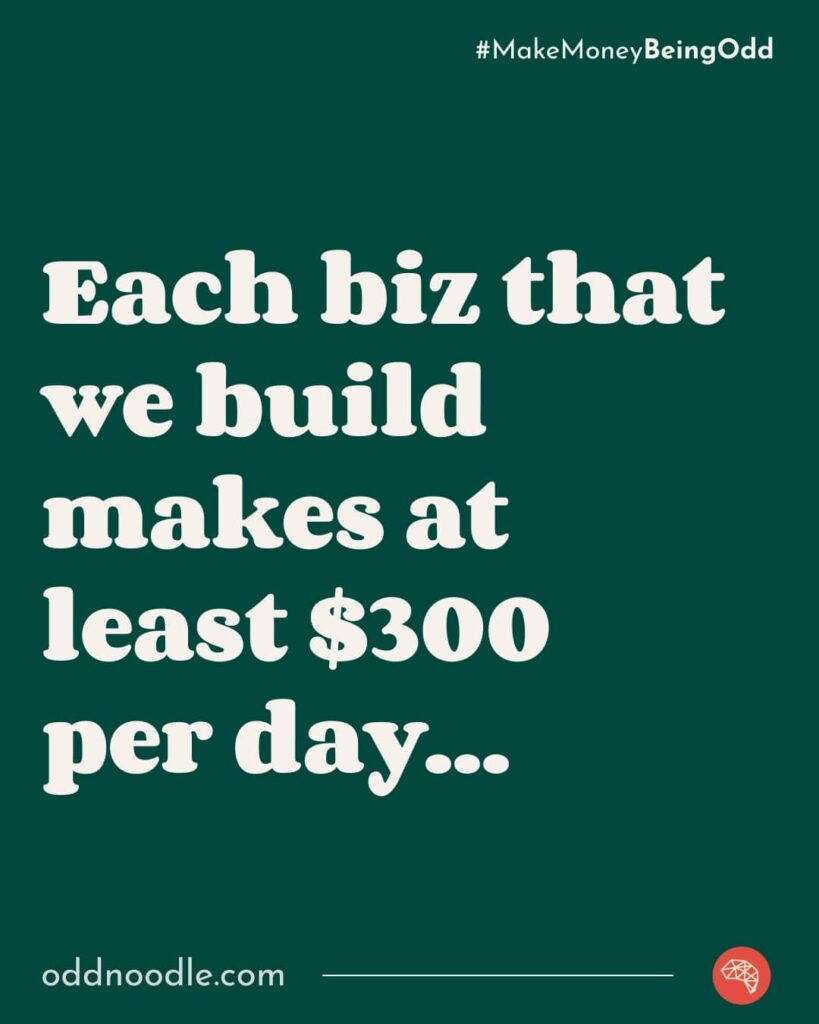In June/July of this year, our SEO strategy was… nothing. We didn’t even blog, really. Not on Odd Noodle.
And to be honest, I don’t remember what the catalyst was that made us decide to tackle it, but we did.
Here is the BEFORE of Odd Noodle search results:
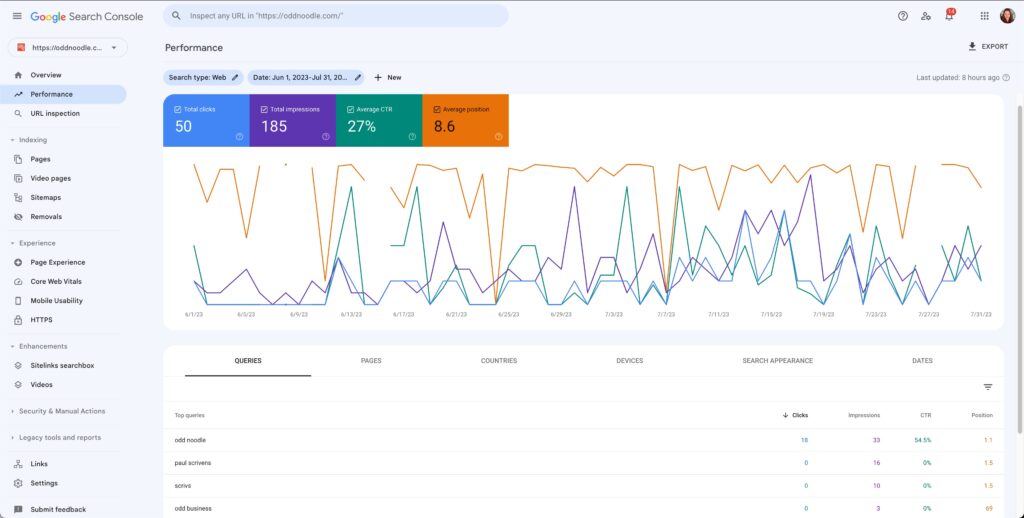
That’s June to July of this year. 185 impressions in a month and 50 clicks.
You might be thinking, wait, how do you even have that little bit going on if you weren’t even blogging on Odd Noodle?
Good question. Check out the things oddnoodle.com was ranking for:
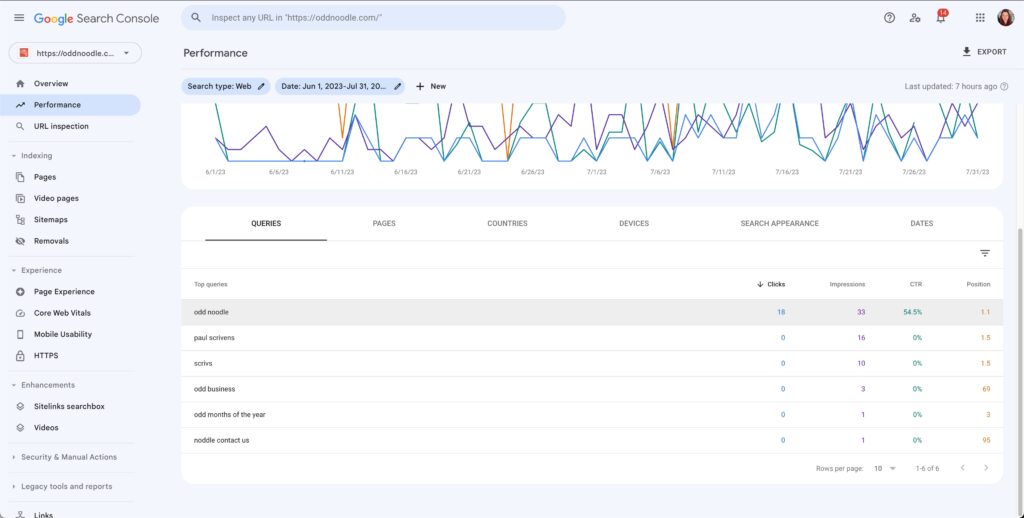
Not one search term that would be any help if we are looking for new people to find us.
Now let’s fast forward to what the last 3 months have been like for Odd Noodle post-revamp of our SEO strategy:
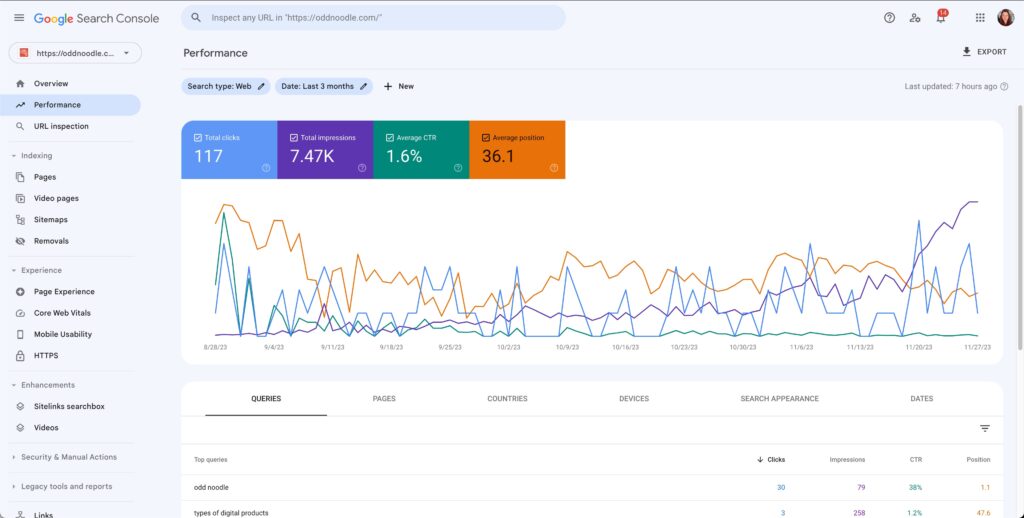
We went from 185 impressions to 7,470.
That means, prior to us doing work on the site, we had 185 pairs of eyeballs in a month that saw something from Odd Noodle show up when they searched for something.
Since doing the work on the site, the total pairs of eyeballs that have seen something from Odd Noodle show up when they searched for something is almost 7.5k. We’ll average that out to about 2500 a month.
And now, this is what the search terms we’re ranking for look like thanks to this SEO strategy:
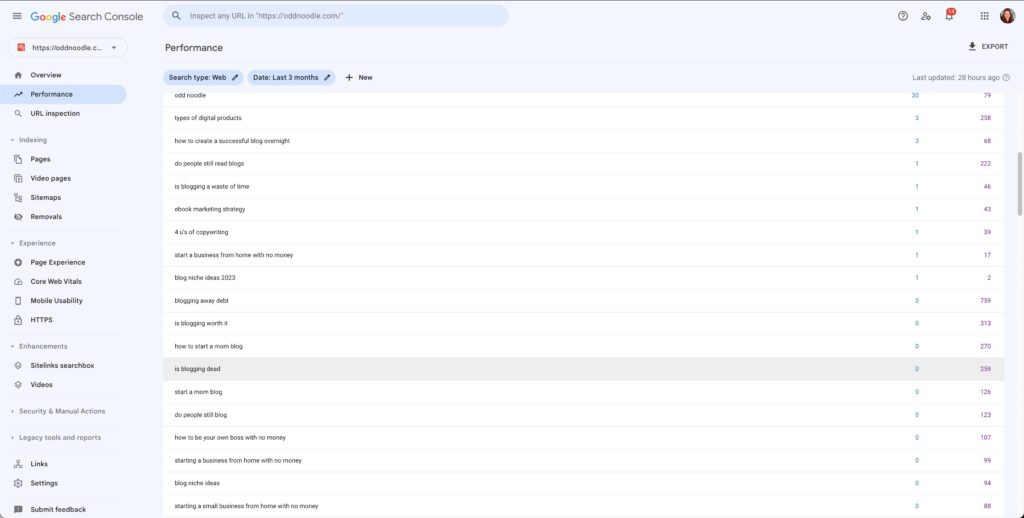
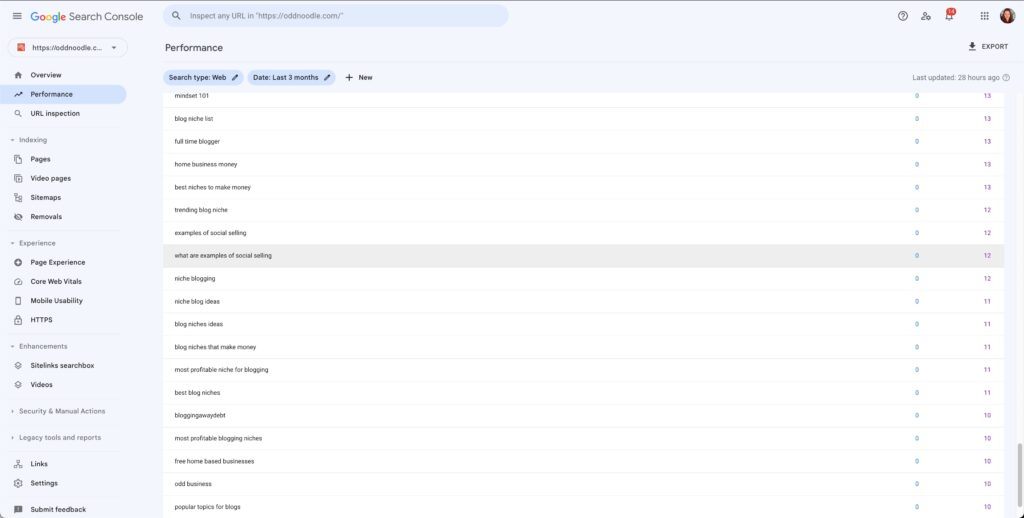
Our SEO Strategy for OddNoodle.com
There are now 372 unique keywords that Odd Noodle is showing up for when a person searches them.
So what is the SEO strategy we used to get those results?
I’ll tell you:
- Moved & updated posts from Struggle.co
- Added & posts from Machined.ai
- Started pinning
- Reviewed titles
- Interlinking (at first and as we saw things starting to rank)
Let’s go through each of these one by one.
Moving & Updating Posts from Struggle.co
Struggle.co is a domain that Scrivs has owned forever. There are a ton of posts on it about making money, saving money, budgeting, side hustles… It covers a LOT.
And it ranks for a lot.
We decided to move anything that was related to what we’re doing at Odd Noodle off of Struggle and onto Odd Noodle.
That would give us the start of a library of posts very quickly, bolstering our SEO strategy.
There are downsides to this, while we might get a quick bump from Google after moving things, we also know that Google doesn’t love redirects and we wouldn’t immediately or consistently see the same results the posts were getting on Struggle.
Here’s an example:
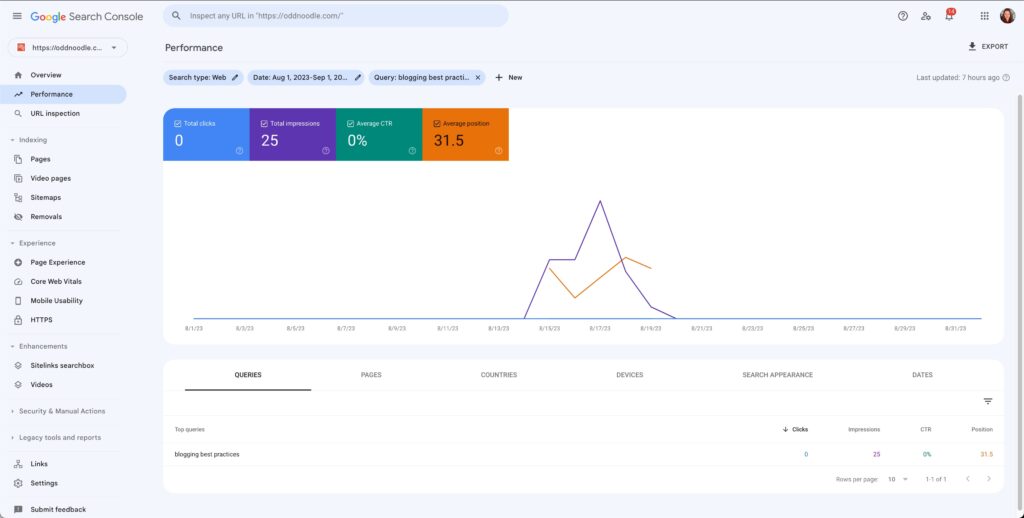
That’s a great keyword for us: blogging best practices.
You can see for a few days after we moved it, it was getting some impressions and ranking at position 31.5.
But you can also see it completely disappears after a few days. (Spoiler alert, it’s back on our list as of this week!).
So, simply moving all of those posts over was not going to be enough if we wanted to sustain any type of ranking.
So as soon as we started moving posts over, we also started updating them as part of our ongoing SEO strategy.
Here are some of the things we did to update them:
- Reviewed the content to make sure it still aligns with how we teach things today. A lot of these posts are several years old, so they needed to be refreshed and their on-page SEO improved.
- Used RankMath to see where we had opportunities to improve our on-page SEO. That means things like, making sure we have the keyword in the appropriate places, making sure the content is as long as it needs to be, linking to external sources, improving titles, and making sure the content is a good reading experience.
- Interlinking! Yes, I gave that an exclamation point because interlinking your blog posts together is a really good way to help your posts rank AND it’s a good way for your reader to discover more of your content. It’s a win-win and it’s easy to do, it’s just hard to REMEMBER to do. This is an essential part of any SEO strategy.
- Added relevant opt-ins or offers to posts. The point of your blog posts is to welcome people into your world. Having a post with nothing in it that offers them a way to actually join that world (like a free opt-in or even an offer) means that they will probably read it once and then never see you again. This doesn’t necessarily help with SEO, but it does help you build your audience.
- Now, I’m using past tense “did” when I talk about updating, but it’s not a one-and-done thing. We update posts whenever we see that they are moving up the ranks in the Search Console.
The thing with any SEO strategy is, it’s a never-ending game. As much as we’re working hard and doing what we can to give our posts the best chance possible to rank, thousands of other bloggers are doing the exact same thing.
Adding New Topic Clusters with Machined.ai
Machined.ai is, you guessed it, an AI tool that greatly complements our SEO strategy by writing blog posts for us.
But it doesn’t just write them, it chooses keywords, writes a cluster of blog posts based on those keywords, AND interlinks all of them together then adds them as drafts to your WordPress site.
It’s amazing, but as with all things AI, it has some flaws.
The posts need rewriting. Like, a lot of rewriting. It’s not like ChatGPT where you can give specific instructions on what you want included or excluded in the post or direction on your unique voice.
However, it will give you lengthy (2500-4000 words) posts for relevant keywords that are interlinked in a way that makes sense. (again, interlinking is a VITAL part of our SEO strategy!)
Your job is to take those posts and make them your own. Just don’t change any of the links :-).
We used Machined to get a lot of posts written in a very short time. I’m talking 80 posts produced in a matter of minutes.
The updating takes time, yes, but the way we handle it is we give them a once over and see if there is anything glaring that needs to be changed immediately.
Then we publish them.
Then we wait.
When we see one pop-up on the search console, we do a more detailed update.
Here’s an example of a post about ebook marketing strategies written by Machined:
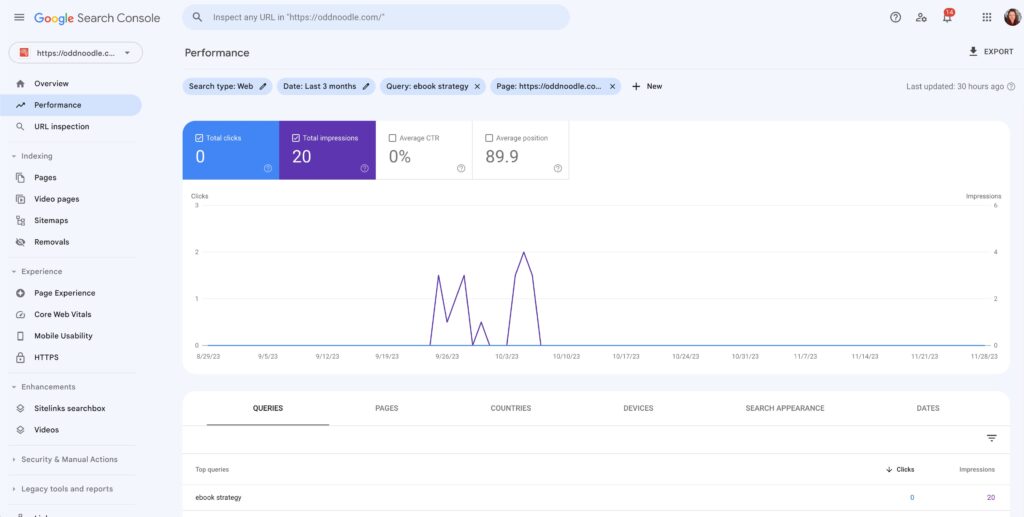
This post was first published at the end of July in its almost raw state, straight out of Machined. Just small updates to make it match the Odd Noodle ways.
In September, it started ranking for the term “ebook strategy”. That was our cue to go back into that post and give it a full update.
Then we wait again to see when it pops back up on search console again.
Pinning Posts to Pinterest
Yeah, we went back to Pinterest.
Not because we think we’re going to get tons of traffic but as another piece of our SEO strategy.
It’s a good signal to Google if someone clicks your pin on Pinterest and then goes and reads your article. That can help your ranking.
Since we started pinning, sometime in September, we’ve published hundreds of pins. We can do that because we have so many posts to work with. It’s harder to do a high volume of pins when you don’t have a lot of posts because you don’t want to be spamming Pinterest with the same urls over and over again.
Now, having so many posts to work with can be a struggle, too. It’s overwhelming to think about pinning 272 posts. So we didn’t.
We strategically chose posts to pin. Here are the criteria:
- It has to be a topic/keyword that will work well on Pinterest. Most of our blogging posts and how to make money posts fit this category.
- If it pops on search console and is in one of those categories, it gets pinned.
- It has to be a post that we’ve updated extensively. With Pinterest we expect people to see a pin, click through and read an article. We don’t want to pin any posts that aren’t fully updated and Odd Noodle-ified.
That left us with 98 posts to pin.
In the beginning, we scheduled batches of 60 pins at a time so that we could move through the list quickly. (Note, we did NOT pin 60 a day, we scheduled 60 a day to be published over the course of several days).
Once we got the initial pins out for that list of 98 posts, we started scheduling 20 pins to be published a day.
Now, the Odd Noodle Pinterest account was a clean slate when we started pinning. It was pretty much starting from scratch.
We created boards and board descriptions based on keywords we found with Pin Inspector. I also use those keywords for pin descriptions (which I write with ChatGPT). This helped automate the process as much as possible because we do not want to spend a TON of time on Pinterest.
Are we getting boatloads of Pinterest traffic like the good old days?
No. Not even close.
But, every click is helpful for now, AND don’t forget Pinterest is a search engine.
So at some point, our pins should start ranking on Pinterest for keywords, further bolstering our SEO strategy.
Here’s where we stand on Pinterest over the last 90 days:
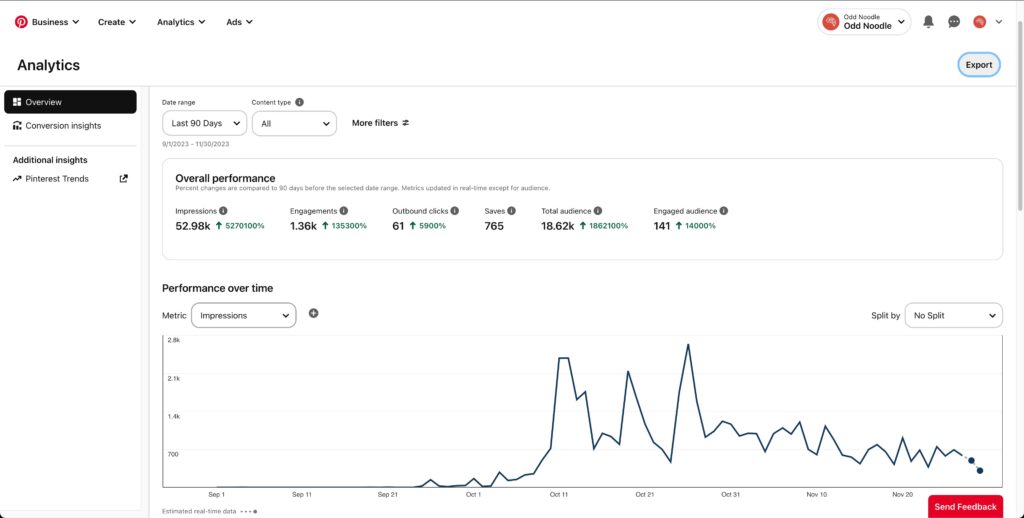
Just so you have a reality check if you decide you’re going to start pinning :-).
Reviewing Titles
Impressions are cool and all, but you don’t make money with impressions.
The chart below looks pretty impressive, right? Impressions are just starting to pop off right now.
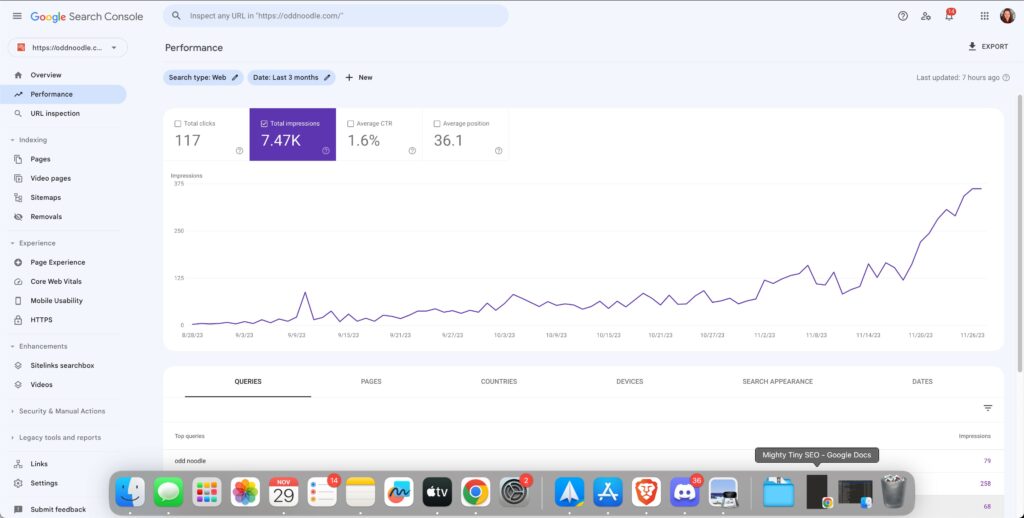
But about 8 million times MORE important than impressions is clicks.
We have over 7k people looking at an Odd Noodle result on Google in the past three months as a result of our SEO strategy.
How do we get them to CLICK and not just keep scrolling? The key lies in our SEO strategy:
We need titles that entice people to click which means understanding how to write good headlines.
Does that mean we sit around thinking of the most creative, clickbait-y but not TOO clickbait-y, curiosity-inducing, psychologically optimized titles?
No.
It means we look at the top result for the keyword we’re after and, well, copy it. Not word for word, but the structure of the title.
If the top result says 3 Blogging Best Practices to Skyrocket Your Audience, then our title is going to include a number, an eye-catching word like “skyrocket” and an outcome (skyrocket your audience).
We could tell you a bunch of different ways and tools to optimize your titles, or we can tell you to go look at what is already working and do that.
The second seems much simpler, right?
So, reviewing titles is part of our normal updating process, but we pay extra special attention to it when we see a post is getting impressions, but no clicks.
Here’s an example:
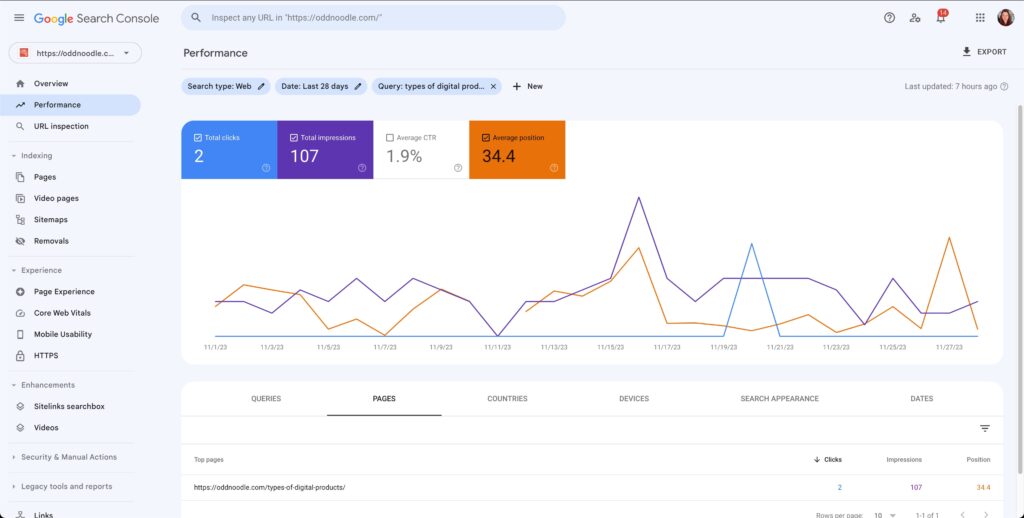
This post had 107 impressions and is averaging around 34 for the position in search results. When we saw that many impressions, but few clicks, we immediately looked at the competition and changed our title accordingly.
We changed the title to “50+ Types of Digital Products You Can Create That People Will Actually Buy (You Can Make #3 in a Weekend!)” because the results at the top of that Google search all included numbers.
The change happened on 11/20, which happens to be the day we got 2 clicks on the post. We’ll keep an eye on it and see if the click-through rate improves.
Interlinking (aka Adding Internal Links)
We talked a little bit about interlinking when talked about the Machined.ai posts. Basically, interlinking is simply adding links to other pieces of content on your site.
But Machined only interlinks the posts it creates.
That means we had a LOT of interlinking to do with the rest of our posts including anything we moved from Struggle and any new posts we wrote. It also meant setting up new topic clusters to help build the topic authority of the site.
Just like with Pinterest, when you’re staring at 200+ published posts, it can feel overwhelming to think about interlinking them all.
So here’s what we did:
- Scanned through all of the Struggle posts we moved to Odd Noodle and updated any links that were still pointing to Struggle, to point to Odd Noodle. We had already been practicing interlinking on Struggle, so a lot of posts had links to other pieces of our content in them, but the links were back to Struggle, which is not going to help Odd Noodles SEO. So those all got updated to Odd Noodle urls.
- Added internal links to and from every new post we wrote.
- Interlinked every time we saw a new post pop up on Search Console.
Here’s an example of #3:
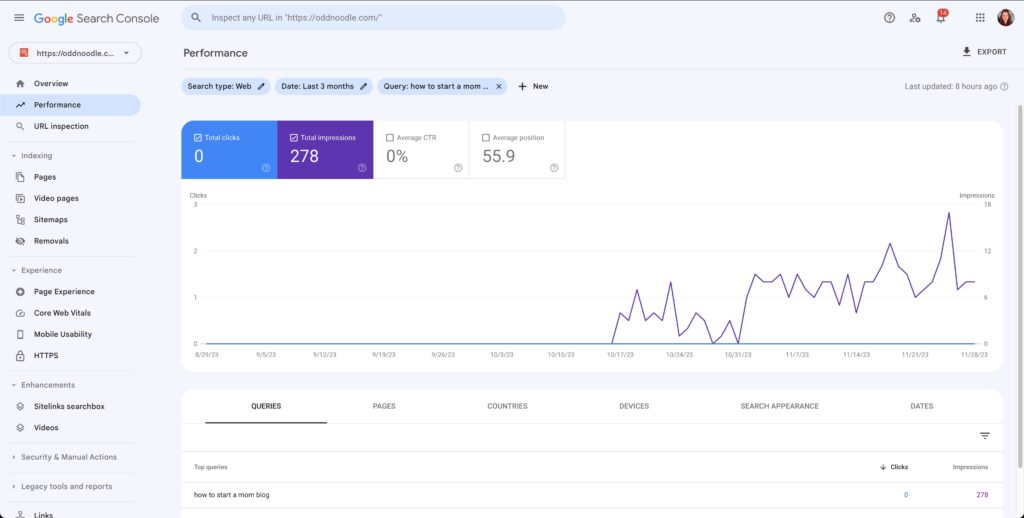
How to Start a Mom Blog started getting impressions about a month and a half ago. When we see that, it’s our cue as part of our SEO strategy, to go find posts on Odd Noodle that we can put a link TO the post about how to start a mom blog with that keyword as the anchor text.
We’ll find 3-5 relevant posts and find a place in each of those posts where we can reference “how to start a mom blog” and add a link.
You do want to do your best to make sure the link makes sense in the context of the post. Don’t just randomly throw a link in just because your want the link.
If someone comes to read a post and see that you’re linking to “how to start a mom blog” in a really relevant, contextual way, they might decide to click that link and read more of your post.
That’s good for your reader and it’s a good signal to Google, too.
Putting It All Together
Now, let’s look at all of this with a real-life example that showcases the impact of our SEO strategy.
On September 8th, we started getting search impressions for the keyword “types of digital products” leading to this post:
https://oddnoodle.com/types-of-digital-products/
This was a post we moved from Struggle. So right after we moved it, we gave it a once over update to make sure that everything in the post matched our current methods.
We also went in and used RankMath to improve the on-page SEO:
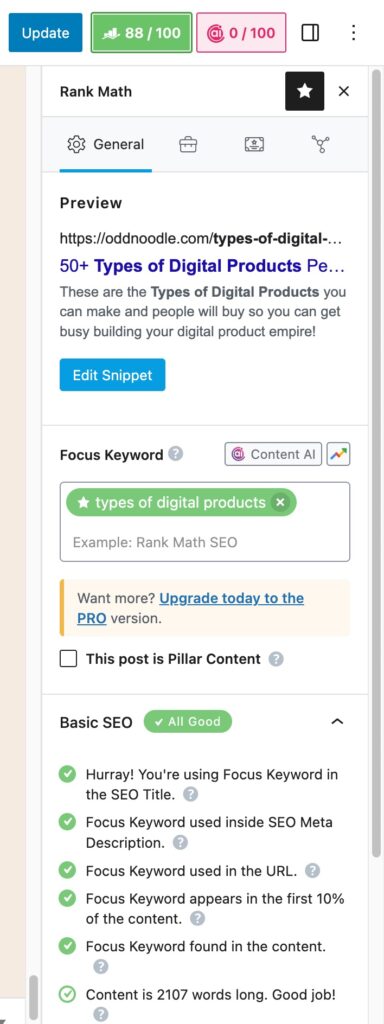

RankMath is one of the easiest and cheapest (free) ways to make sure you’re doing as much as possible for your on page SEO. Highly recommend, BUT…
It’s probably not going to be what pushes you past the competition. Because the competition is doing all of these things as well.
So, after updating for RankMath, we did all of the other things we’ve talked about.
We scheduled pins. We found other Odd Noodle posts we could link to this one from. We updated the title.
Now, this is a really, really good keyword for us to rank for. It’s not going to be easy to continue to move up the search results ladder on this one.
So to take things even one step further, we recorded a video (a podcast episode, actually), uploaded it to Youtube and then embedded the video into the blog post. Google likes videos in blog posts.
Let’s look at the life of this post since it started popping up on Search Console:
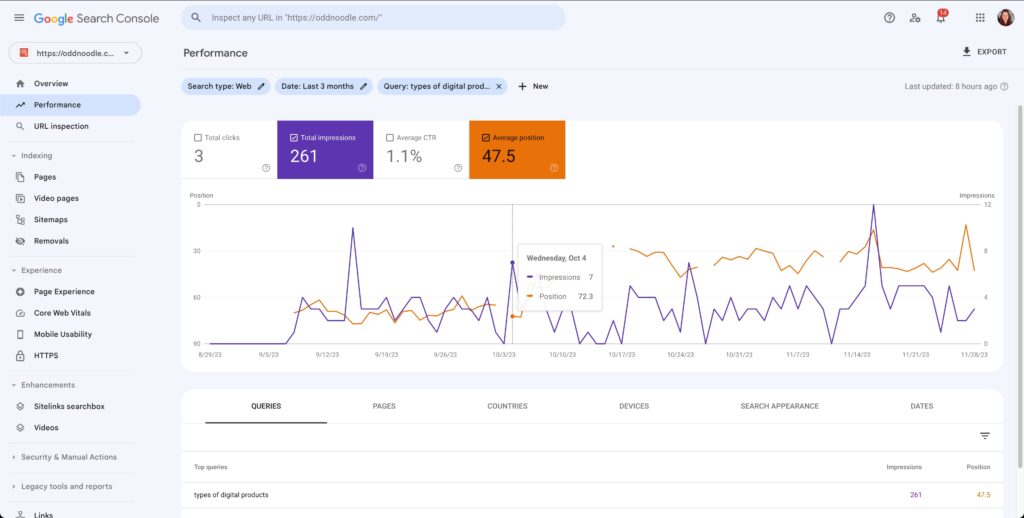
We’re looking at impressions and average position in this chart.
Impressions have been steadily spiking and dropping (that’s gotta be an oxymoron), but on the best day, we’re talking about 12 impressions a day. So, it looks volatile, but the numbers are small so looks here are deceiving. It’s an average of about 3 impressions per day over the course of 3 months.
But the average position is on a nice trajectory.
On the day that the keyword popped up in Search Console, its average position was 70.
That basically means out of 100 search results for “types of digital products”, our post was the 70th result.
But, if we look at the last week, the average position is 37.4. That’s a nice jump. It tells us that what we’re doing with our SEO strategy is working.
What it does NOT tell us is that we can just sit back now and wait for the post to keep climbing.
We have to keep finding ways to improve the post, keep pinning, and keep checking on what the competition is doing.
SEO is really not a passive thing. You don’t write a post, optimize it, and wait for the traffic & money to roll in. It’s something your competition is working on constantly, which means you need to, too.
Final Thoughts on SEO Strategy
Before you run off to implement what we’ve shown you here, there’s a really important thing to remember about this SEO Strategy (or any SEO strategy for that matter).
None of this work matters if the post stinks. Or if the site is a terrible reading experience.
If you have people clicking from search results and spending very little time on your site because the post isn’t engaging or there are 7 million ads and pop-ups chasing them away, then you’re not going to build an audience and Google is not going to like to see them leaving your post so quickly either.
Remember, the reason we do SEO is to help people who are interested in improving their life in some way, find our help in getting that improvement.
Those are the people who will sign up for your email list and buy your products.
SEO strategy is not a “Rank #1 Contest!”. It’s a “Let the People I Want to Help Find Me As Easily and Often As Possible” contest.
The quality of the content and the reading experience matter above all else.

